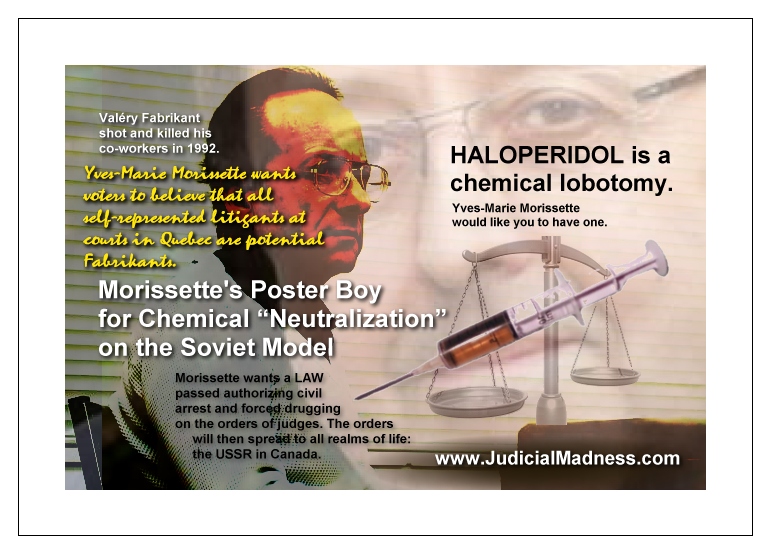May v Ferndale Inst. [2005] 3 SCR 809
WARNING
|
May v Ferndale Institution, 2005 SCC 82 at paras 70-71, [2005] 3 SCR 809
Is this Habeas or other?
Source: http://www.canlii.org/en/bc/bcsc/doc/2001/2001bcsc1335/2001bcsc1335.html
May v. Warden of Ferndale Institution, 2001 BCSC 1335 (CanLII)
Date: 2001-09-25
Docket: CC010801; CC010802; CC010805; CC010806; CC010807
Other citation: [2001] BCJ No 1939 (QL)
Citation: May v. Warden of Ferndale Institution, 2001 BCSC 1335 (CanLII),
Cited by 3 documents
Hide
CanLII Connects
No summaries or commentary from the legal community available — Add your own
Maritime Law Book
MLB Key Number Breakdown
MLB Headnotes for this decision
Topics
ADMINISTRATIVE LAW: JUDICIAL REVIEW, CERTIORARI;General principles: Jurisdiction to grant certiorari (5010)
HABEAS CORPUS: JURISDICTION TO ISSUE WRIT;General: Jurisdiction of provincial superior courts over inmates in federal penitentiaries (510)
PRISONS: ADMINISTRATION;Powers re prisoners: Transfers (incl. international transfers) (1026)
Legislation cited
Constitution Act, 1982, The, Schedule B to the Canada Act 1982 (UK), 1982, c 11 — 10 Cited by 32,237 documents
Corrections and Conditional Release Act, SC 1992, c 20 — 28; 29 Cited by 2,010 documents
Federal Courts Act, RSC 1985, c F-7 — 2; 18 Cited by 6,509 documents
Decisions cited
Bachynski v. William Head Institution, [1995] BCJ No 1715 (QL), 57 ACWS (3d) 2 (not available on CanLII) Cited by 19 documents
Balian v. Reg. Transfer Bd., 62 CR (3d) 258 (not available on CanLII) Cited by 17 documents
Fisk v. Canada (Pacific Region Correctional Service), [1996] BCJ No 179 (QL) (not available on CanLII) Cited by 10 documents
Hay v. Nat. Parole Bd., 21 CCC (3d) 408, 13 Admin LR 17, [1985] FCJ No 610 (QL), 18 CRR 313 (not available on CanLII) Cited by 22 documents
R. v. Miller, [1985] 2 SCR 613, 1985 CanLII 22 (SCC) Cited by 162 documents
Citation:
May et al. and Owen v. Warden of Ferndale Institution et al.
Date:
20010925
2001 BCSC 1335
Docket:
CC010801
CC010805
CC010806
CC010807
Registry: Vancouver
IN THE SUPREME COURT OF BRITISH COLUMBIA
BETWEEN:
TERRY LEE MAY
GARETH WAYNE ROBINSON
MAURICE YVON ROY
SEGUN UTHER SPEER-SENNER
APPLICANTS
AND:
WARDEN OF FERNDALE INSTITUTION,
WARDEN OF MISSION INSTITUTION,
THE DEPUTY COMMISSIONER, PACIFIC REGION
CORRECTIONAL SERVICE OF CANADA AND
ATTORNEY GENERAL OF CANADA
RESPONDENTS
Docket:
CC010802
Registry: Vancouver
IN THE SUPREME COURT OF BRITISH COLUMBIA
BETWEEN:
DAVID EDWARD OWEN
APPLICANT
AND:
WARDEN OF FERNDALE INSTITUTION,
WARDEN OF MATSQUI INSTITUTION,
THE DEPUTY COMMISSIONER, PACIFIC REGION
CORRECTIONAL SERVICE OF CANADA AND
ATTORNEY GENERAL OF CANADA
RESPONDENTS
REASONS FOR JUDGMENT
OF THE
HONOURABLE MR. JUSTICE BAUMAN
Counsel for Applicants, Robinson, Roy and Speer-Senner
D.M. Turko
Counsel for the Applicants, May and Owen
A.H. Pollak
Counsel for Respondents
C. Workun, B. Lomax and
S. Parks
Date and Place of Hearing/Trial:
6 July 2001
Vancouver, B.C.
[1] The five applicants are inmates serving sentences in federal institutions within British Columbia. They each bring application for relief in the nature of habeas corpus with certiorari in aid directing the responsible Corrections officials to transfer them from the medium security institutions, where they currently reside, to minimum security facilities, from which they each were involuntarily transferred.
[2] The issues before me include:
(a) whether relief in the nature of habeas corpus is available in the circumstances from a provincial superior court; and
(b) if it is, whether each of the applicants has made out a case for that relief?
[3] A number of facts are common to each of the applicants:
(i) each is serving a sentence for murder or manslaughter;
(ii) each in the recent past was transferred to a minimum security institution within British Columbia, and in the more recent past, each was transferred involuntarily back to a medium security institution within British Columbia; and
(iii) each, with the exception of the applicant, May, received a Notice of Involuntary Transfer Recommendation pursuant to s. 29 of the Corrections and Conditional Release Act, S.C. 1992, c. 20, which begins in part:
…
As instructed by Regional Headquarters (Pacific), a review of the security classifications of offenders at Ferndale institution serving a life sentence and who have not completed a violent offender progam [sic] was conducted. Tools utilised included both the CJIL/Computerised Re-classification Scale and the Offender Security Classification, which provides a rationale in the three areas of Institutional Adjustment, Escape Risk and Public Safety Concern.
The Computerised Re-classification Scale yielded a medium-security rating. Similarly, the Offender Security Classification provided a rationale, which is consistent with a medium-security offender.
…
(iv) the decision on May’s second level grievance echoes the theme emerging in respect of his four colleagues:
…
As a result of a regional review of all offenders in minimum security serving a Life sentence who had not completed violent offender programming, your security rating was adjusted to medium. The security classification tool cannot rate an offender in your circumstances as minimum, therefore you were appropriately transferred to a medium security facility.
…
[4] I begin with the threshold issue: does a provincial superior court have jurisdiction to review a federal prisoner’s involuntary transfer on an application for habeas corpus.
[5] The question arises, of course, because of the tension thrown up by the Federal Court’s exclusive jurisdiction in respect of certiorari proceedings involving the decisions of federal tribunals (s. 18 of the Federal Court Act) and the habeas corpus jurisdiction of provincial superior courts.
[6] Two decisions in this court were cited by counsel in argument. In Fisk v. Canada (Pacific Region Correctional Service), [1996] B.C.J. No. 179 (S.C.) (Q.L.), (at para. 38), Justice Drost held:
What the petitioner is saying is that the decision to rate him as a maximum security offender was made in an unfair manner because he was not given the full particulars and a reasonable opportunity to respond. In other words, he maintains that there was a lack of procedural fairness. If so, his proper course is to challenge the decision by way of certiorari proceedings in the Federal Court Trial Division which has been given statutory jurisdiction to review decisions made under the Federal Corrections Act.
[7] Justice Bouck considered the jurisdictional issue in Bachynski v. William Head Institution, [1995] B.C.J. No. 1715 (S.C.) (Q.L.) (at paras. 23 and 24):
First of all, the Respondent’s do not contest the availability of the remedy in this case. A convenient summary of the law can be found in Balian v. Regional Transfer Board (1988), 62 C.R. (3d) 258 at 260-262 (Ontario Supreme Court [High Court of Justice]. Certiorari in aid is a remedy in the nature of an order allowing this court to make the remedy of habeas corpus more effective by requiring production of the record of the proceedings in the tribunal below. That order was not sought in these proceedings. Certiorari to quash is a remedy in the nature of an order setting aside the decision of a tribunal. It is not available to a provincial superior court where it is directed at a federal tribunal because the granting of such an order is within the exclusive jurisdiction of the Federal Court.
Nonetheless, on an application for habeas corpus, a court may inquire into the detention of a prisoner and determine whether it occurred according to law. If I find the transfer of the Petitioner from William Head to Kent was not done according to law, he may by order of the court be transferred back to William Head.
[8] Neither decision expressly refers to that of the Supreme Court of Canada in R. v. Miller, 1985 CanLII 22 (SCC), [1985] 2 S.C.R. 613, 23 C.C.C. (3d) 97, which authoritatively deals with the issue.
[9] I extract this somewhat lengthy discussion of the relationship between s. 18 of the Federal Court Act and the habeas corpus jurisdiction from Justice Le Dain’s decision for the court (at para. 14):
… While s. 18 of the Federal Court Act confers an exclusive and very general review jurisdiction over federal authorities by the prerogative and extraordinary remedies, to which specific reference is made, it deliberately omits reference to habeas corpus. That this was not an oversight but a well considered decision is indicated by s. 17(5) of the Act, which expressly confers exclusive jurisdiction on the Federal Court with respect to an application for habeas corpus by a member of the Canadian Forces serving outside Canada. I agree with Laskin C.J. that because of its importance as a safeguard of the liberty of the subject habeas corpus jurisdiction can only be affected by express words. One may think of reasons why it was thought advisable to leave the habeas corpus jurisdiction with respect to federal authorities with the provincial superior courts, including the importance of the local accessibility of this remedy. The important thing, as I see it, is that the decision to create this exception to the exclusive review jurisdiction of the Federal Court, with whatever problems arising from concurrent or overlapping jurisdiction it might cause, is really determinative of the question of jurisdiction to issue certiorari in aid. There can be no doubt that certiorari in aid is important, if not essential, to the effectiveness of habeas corpus. This was emphasized by both Anderson J.A., with whom the other members of the British Court of Appeal agreed on this issue in Cardinal, and by Cory J.A. in the case at bar. In many cases it may not be possible for a court to determine whether there has been an absence or excess of jurisdiction if the record of the tribunal which imposed or authorized the detention is not brought before it. The importance of habeas corpus itself, and by implication the importance of maintaining it as a fully effective remedy is, as Laskin C.J. observed, given particular emphasis by its inclusion as a guaranteed right in s. 2(c)(iii) of the Canadian Bill of Rights. To this recognition may now be added the constitutional guarantee of the right to habeas corpus in s. 10(c) of the Canadian Charter of Rights and Freedoms. Because of the clear intention to leave the habeas corpus jurisdiction over federal authorities with the provincial superior courts and the importance of certiorari in aid to the effectiveness of habeas corpus, it cannot, in my opinion, have been intended that the reference to certiorari in s. 18 of the Federal Court Act should have the effect of undermining or weakening the habeas corpus jurisdiction of the provincial superior courts by the exclusion or denial of certiorari in aid. Certainly such a construction is to be avoided if at all possible. It can be avoided by application of the distinction emphasized by Laskin C.J. between certiorari as an independent and separate mode of review having as its object to quash the decision of an inferior tribunal and certiorari as an ancillary procedure used to serve an essentially evidentiary purpose. A very full discussion of this distinction, with reference to many of the decisions in which it has been noted and applied, is to be found in Cromwell, “Habeas Corpus and Correctional Law” (1977), 3 Queen’s L.J. 295 at pp. 320-23. Applying the distinction to the reference to certiorari in s. 18 of the Federal Court Act, it is reasonable to conclude, because of the association in that section of certiorari with the other prerogative and extraordinary remedies, that the reference is to the independent remedy of certiorari to quash. It is unlikely that Parliament intended to confer an exclusive jurisdiction to issue certiorari in aid when it had clearly withheld the jurisdiction to issue habeas corpus. For these reasons I conclude that a provincial superior court has jurisdiction to issue certiorari in aid of habeas corpus to review the validity of a detention authorized or imposed by a federal board, commission or other tribunal as defined by s. 2 of the Federal Court Act, and that accordingly the Ontario Court of Appeal did not err in concluding as it did on this issue.
[10] I underline, however, that the jurisdiction enjoyed by this court is one allowing it to determine the lawfulness of the impugned decision on the basis of an absence or excess of jurisdiction.
[11] This is made even clearer by Justice Le Dain at para. 20 of his reasons:
The above passage, in my respectful opinion, reflects the true distinction or criterion respecting the consideration of extrinsic evidence on an application for habeas corpus — the distinction between issues going to the merits and issues going to jurisdiction. The issues in both Schumiatcher and Goldhar were clearly issues going to the merits. The same is true of Re Trépanier, where the applicant alleged that the convicting magistrate erred on the facts in convicting him. He sought a writ of habeas corpus with certiorari in aid to bring up the record of the proceedings to ascertain whether there was sufficient evidence to convict. This was clearly an attempt to employ habeas corpus to review the merits of a conviction. Ritchie C.J. said at p. 113:
The jurisdiction of the magistrate being unquestionable over the subject-matter of complaint and the person of the prisoner, and there being no ground for alleging that the magistrate acted irregularly or beyond his jurisdiction, and the conviction and warrant being admitted to be regular, the only objection being that the magistrate erred on the facts and that the evidence did not justify the conclusion as to the guilt of the prisoner arrived at by the magistrate, I have not the slightest hesitation in saying that we cannot go behind the conviction and inquire into the merits of the case by the use of the writ of habeas corpus.
[12] In the petitions before me, the applicants argue that they have been denied procedural fairness in the decision making process leading to their involuntary transfers.
[13] It is their general submission that it was only a change in general policy – a direction from headquarters to review the security classifications of offenders at Ferndale serving a life sentence utilizing the CJIL/Computerized Reclassification Scale and the Offender Security Classification – that prompted their transfers.
[14] In this sense it is urged by the applicants that each of the transfers was arbitrary, made in the absence of any “fresh” misconduct on their parts and without a consideration of the individual merits of each case.
[15] On a more specific basis, the applicants also submit that their right to procedural fairness was breached by a non-disclosure of the scoring matrix for the CJIL model.
[16] It is said that without that basic information, one is unable to challenge the usefulness of that assessment tool in the decision making process.
[17] However, the respondents have indicated that a scoring matrix is not available and this ground must, therefore, fail as there has not been a non-disclosure of available information which might assist the applicants in their submissions.
[18] Returning, however, to the applicants’ primary submission, it is based essentially on the argument that the responsible Corrections officers have simply applied an arbitrary new policy to the applicants without considering the individual merits of their cases under ss. 28 and 29 of the Corrections and Conditional Release Act and its regulations.
[19] If made out, that argument is one going to the jurisdiction of the Corrections officers to lawfully transfer the applicants to a medium security institution.
[20] It suffices to summarize the statutory scheme by noting that s. 29 of the Act authorizes an inmate transfer after a consideration of the criteria set out in s. 28 and after offering the inmate the procedural safeguards contemplated by the regulations.
[21] The scheme very much requires the consideration of the individual merits of each case and it follows that the arbitrary application of a general policy without that consideration is not within the jurisdiction mandated by the legislation.
[22] Because the applicants put their case on the basis of an alleged absence or excess of jurisdiction, habeas corpus with certiorari in aid lies to review the validity of the transfer decisions: Miller (supra).
[23] I turn then to consider whether, in fact, each transfer here has been motivated solely by the arbitrary application of a general policy.
[24] It is true that each of the decisions resulted from a review apparently prompted by a general instruction from headquarters to “review … security classifications of offenders at Ferndale Institution serving a life sentence …”, but that, in itself, is not objectionable so long as there has been a true review of each inmate’s case in light of the statutory criteria. And an examination of each of the applicants’ files indicates that there was.
[25] Each of the applicants scored a medium security rating on the assessment tools utilized by the Correctional Service. From there, a review of each file indicates that the responsible officers considered each of the applicants’ individual situations.
[26] In almost all of the cases, there was a concern expressed by the reviewing officers that the inmate in question had failed to adequately address the factors contributing to his index offence by completing a Violent Offender Program and this led to the conclusion that the risk presented by the inmate could no longer be managed at the minimum security level.
[27] In many of the cases, the responsible officers have had the benefit of recent psychiatric and psychological assessments which identify various concerns with individual applicants and recommend treatment or behaviour modification goals.
[28] In each of the cases, the individual applicants have taken advantage of the grievance procedure with the assistance of submissions from counsel, and their transfers have been reviewed by other responsible Corrections officers in accordance with the grievance process.
[29] In each case, a further written decision with reasons has been rendered.
[30] In short, and without an extensive reproduction of the reasons for the decisions, it is apparent from my review of each petition that the responsible Corrections officers have considered (and reconsidered) each case on an individual basis and upon its own singular merits. The decisions in each case are reasoned and based upon specific concerns with each inmate. These cases are not the “quintessence of unfairness and arbitrariness” that was the case in Hay v. Canada (National Parole Board) (1985), 21 C.C.C. (3d) 408, [1985] F.C.J. No. 610 (F.C.T.D.) (Q.L.).
[31] What the applicants would really have the court do is weigh afresh the evidence which was before the “tribunals” below and substitute the court’s opinion of an appropriate institutional setting for these inmates for that of those charged with making the initial decisions.
[32] That is not an appropriate role for the court to adopt on judicial review of these decisions. That role, as I have discussed, is concerned not with the merits of the decisions, but rather with whether they were made in the absence of or in excess of jurisdiction.
[33] It follows that the petitions of May, Robinson, Roy and Speer-Senner are dismissed. Mr. Owen’s petition is dismissed, but he shall have liberty to reapply, because it is apparent that while he was successful on his third level grievance the responsible officers are reviewing his complaint with a view to preparing a new disposition. He should have the opportunity to seek judicial review of that final decision.
“R.J. Bauman, J.”
The Honourable Mr. Justice R.J. Bauman




